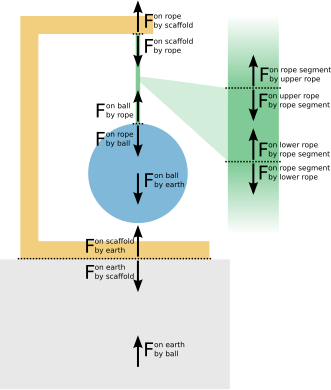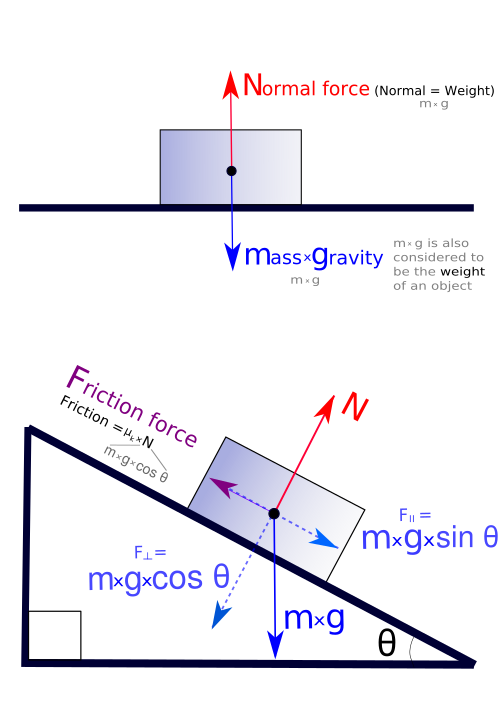OCR Specification focus:
‘Identify tension, normal contact force, upthrust and friction acting on objects in context.’
In everyday physics, objects interact through forces that arise from direct contact or through fluids such as air and water. Understanding contact and fluid forces allows us to analyse motion, predict equilibrium, and describe how real-world systems behave under the influence of multiple interactions.
Contact Forces
Contact forces act when objects touch. These include tension, normal contact force, and friction, all of which depend on the surfaces or materials involved.
Tension
When a rope, cable, or string pulls on an object, it exerts a tension force directed away from the object along the rope’s length. Tension always acts to oppose stretching, keeping the rope taut and transmitting force between connected bodies.

Forces on a mass suspended by a rope: the rope exerts tension on the mass and the support, with equal magnitude along the rope in the idealised case. Arrows are located at the points of action, clarifying how tension is transmitted. Extra details such as force labels on the scaffold are shown for completeness but remain within A-Level expectations. Source.
Tension: The pulling force transmitted through a stretched string, cable, or rope when it is attached to an object and under load.
Tension occurs in systems such as suspended weights, towed vehicles, and stretched springs. In an idealised model, the rope is considered massless and inextensible, meaning the tension is the same throughout its length. In reality, the rope’s mass and elasticity can cause variations, but for most A-Level problems these are negligible.
Normal Contact Force
The normal contact force acts perpendicular to a surface whenever an object is in contact with it. This force arises from the compression of atoms at the point of contact and prevents objects from occupying the same space.
Normal Contact Force: The reaction force exerted by a surface on an object, perpendicular to the surface, opposing penetration.
For example, a book resting on a table experiences a normal contact force upward that balances its weight, resulting in equilibrium. On an incline, the normal force acts at right angles to the surface, not vertically upward. Its magnitude depends on both the angle of the surface and the weight of the object.

Free-body diagram for a block on an incline showing weight (W), normal contact force (N) perpendicular to the surface, and friction (f) opposing impending or actual motion. The diagram also depicts the flat-surface case for contrast. Labels are minimal and clear, matching the level of the syllabus. Source.
Friction
The frictional force opposes relative motion or the tendency of motion between two surfaces in contact. Friction depends on surface texture, material properties, and the normal contact force.
Friction: The resistive force acting parallel to the contact surface that opposes relative motion between two bodies in contact.
There are two main types of friction:
Static friction – acts when there is no motion between surfaces; it increases up to a maximum value before sliding begins.
Kinetic (sliding) friction – acts when the surfaces slide past each other; it usually has a smaller magnitude than maximum static friction.
The size of frictional force can be modelled as F = μR, where μ is the coefficient of friction and R is the normal contact force.
EQUATION
—-----------------------------------------------------------------
Frictional Force (F) = μR
F = Frictional force (N)
μ = Coefficient of friction (no unit)
R = Normal contact force (N)
—-----------------------------------------------------------------
Friction is essential for motion control — it enables walking, driving, and gripping, yet also causes energy loss through heat. In practical contexts, lubricants and smooth surfaces are used to reduce friction, while rough textures or tyres are designed to increase friction for safety.
Fluid Forces
Fluids, which include liquids and gases, exert forces on objects moving through them. The two key fluid forces relevant to this subsubtopic are drag and upthrust.
Drag
Although drag is explored more deeply in later topics, it is introduced here as a fluid contact force that opposes motion through a fluid. It acts in the direction opposite to the object’s velocity and increases with speed. In air, drag is often referred to as air resistance; in liquids, it is called viscous drag.
The magnitude of drag depends on:
The speed of the object through the fluid.
The shape and surface area of the object.
The density and viscosity of the fluid.
This force always acts to resist motion, contributing to effects such as terminal velocity when falling objects reach a steady speed.
Upthrust
Upthrust, also known as the buoyant force, acts on any object partially or fully immersed in a fluid. It acts vertically upward and opposes the weight of the displaced fluid.
Upthrust: The upward force exerted by a fluid on an immersed object, equal to the weight of the fluid displaced.
Upthrust is the reason some objects float while others sink. The magnitude of upthrust depends on the volume of fluid displaced and the density of the fluid. When the upthrust equals the object’s weight, the object floats at equilibrium.

Diagram illustrating upthrust (buoyant force) acting upward on an object in a fluid and opposing weight. Labels emphasise the dependence on displaced fluid consistent with Archimedes’ idea. The page also includes additional figures about density and floating conditions; these go slightly beyond the syllabus but reinforce the core definition of upthrust. Source.
EQUATION
—-----------------------------------------------------------------
Upthrust (U) = ρVg
U = Upthrust (N)
ρ = Density of fluid (kg m⁻³)
V = Volume of displaced fluid (m³)
g = Gravitational field strength (N kg⁻¹)
—-----------------------------------------------------------------
This principle underlies ship design, hot-air balloon lift, and the operation of submarines, all of which rely on careful control of displaced fluid mass.
Combining Contact and Fluid Forces
In real situations, objects often experience multiple forces simultaneously. For example, a car moving along a road experiences:
Driving force from the engine (forward).
Friction and air resistance (opposing motion).
Weight (downward due to gravity).
Normal contact force (upward from the road surface).
By constructing free-body diagrams, these can be resolved to find the net or resultant force, determining acceleration or equilibrium. Correct identification of all contact and fluid forces is essential before applying Newton’s laws of motion.
Summary of Key Ideas
Contact forces include tension, normal contact force, and friction.
Fluid forces include upthrust and drag.
Each force has a specific direction, point of action, and physical origin.
Understanding these allows precise application of F = ma to predict motion or stability in varied contexts.
FAQ
The type of material and the amount of deformation under load determine whether a contact force behaves elastically or rigidly.
Elastic contact (e.g. a spring or rubber band) stores potential energy when stretched or compressed and returns to its original shape when the force is removed.
Rigid contact (e.g. a steel block on a table) deforms negligibly, so the normal contact force arises almost instantaneously from atomic repulsion.
In real materials, most contacts show a combination of both behaviours, but for A-Level calculations rigid contact is assumed unless stated otherwise.
The normal contact force balances only the component of weight perpendicular to the surface. On an inclined plane, the normal force equals W cos θ, which is less than the full weight.
It can also differ from weight if other vertical forces are present, such as:
Lift or thrust from a vehicle.
Upward acceleration (normal force greater than weight).
Downward acceleration (normal force less than weight).
Thus, equality between weight and normal force applies only for objects at rest on a horizontal surface.
The coefficient of friction depends on:
Surface roughness: Microscopic peaks and troughs interlock, creating resistance.
Material type: Metals, rubber, and wood have distinct molecular interactions.
Surface contamination: Lubricants reduce friction; dust or corrosion can increase it.
Temperature: Heating can soften materials or melt lubricants, altering friction.
It is largely independent of surface area in contact, provided normal force remains constant.
Within a fluid, pressure increases with depth. The fluid exerts forces on every part of the object’s surface:
The bottom surface experiences a greater pressure than the top.
The difference in these pressures produces a net upward force, known as upthrust.
This microscopic imbalance of molecular impacts creates macroscopic buoyancy. It explains why the upthrust equals the weight of the displaced fluid, as described by Archimedes’ principle.
When two surfaces slide, microscopic contact points deform and break repeatedly. The mechanical work done against friction converts to thermal energy, raising the temperature of both surfaces.
Consequences include:
Wear: Gradual removal of surface material.
Heating: Energy loss reducing mechanical efficiency.
Changes in friction coefficient: Heat may cause melting or oxidation, altering surface texture.
This is why machines use lubricants — they separate surfaces with a thin fluid layer, reducing both wear and heat production.
Practice Questions
Question 1 (2 marks)
A student pushes a wooden block across a flat surface.
(a) Identify the two main contact forces acting on the block and state the direction of each.
Mark scheme:
1 mark for identifying friction acting opposite to the direction of motion.
1 mark for identifying the normal contact force acting perpendicular and upward from the surface.
Question 2 (5 marks)
A solid metal sphere is suspended from a light string and lowered into a tank of water until it is completely submerged but not touching the bottom.
(a) Name all the forces acting on the sphere.
(b) Draw a labelled diagram showing these forces.
(c) Explain, using the forces you have identified, how the magnitude of the tension in the string changes as the sphere is lowered into the water and reaches full submersion.
Mark scheme:
(a)
1 mark for identifying weight acting downward.
1 mark for identifying tension in the string acting upward.
1 mark for identifying upthrust (buoyant force) acting upward.
(b)
1 mark for a clear, labelled diagram with correct directions of forces (weight downward, tension and upthrust upward).
(c)
1 mark for a correct explanation: as the sphere is lowered, upthrust increases due to the displaced water.
1 mark for stating that tension decreases because upthrust partially balances the weight of the sphere when submerged.

